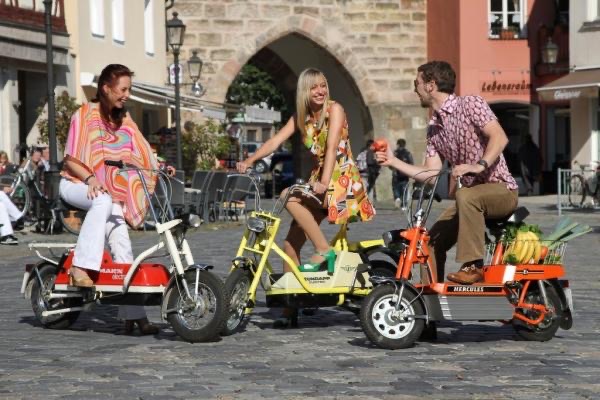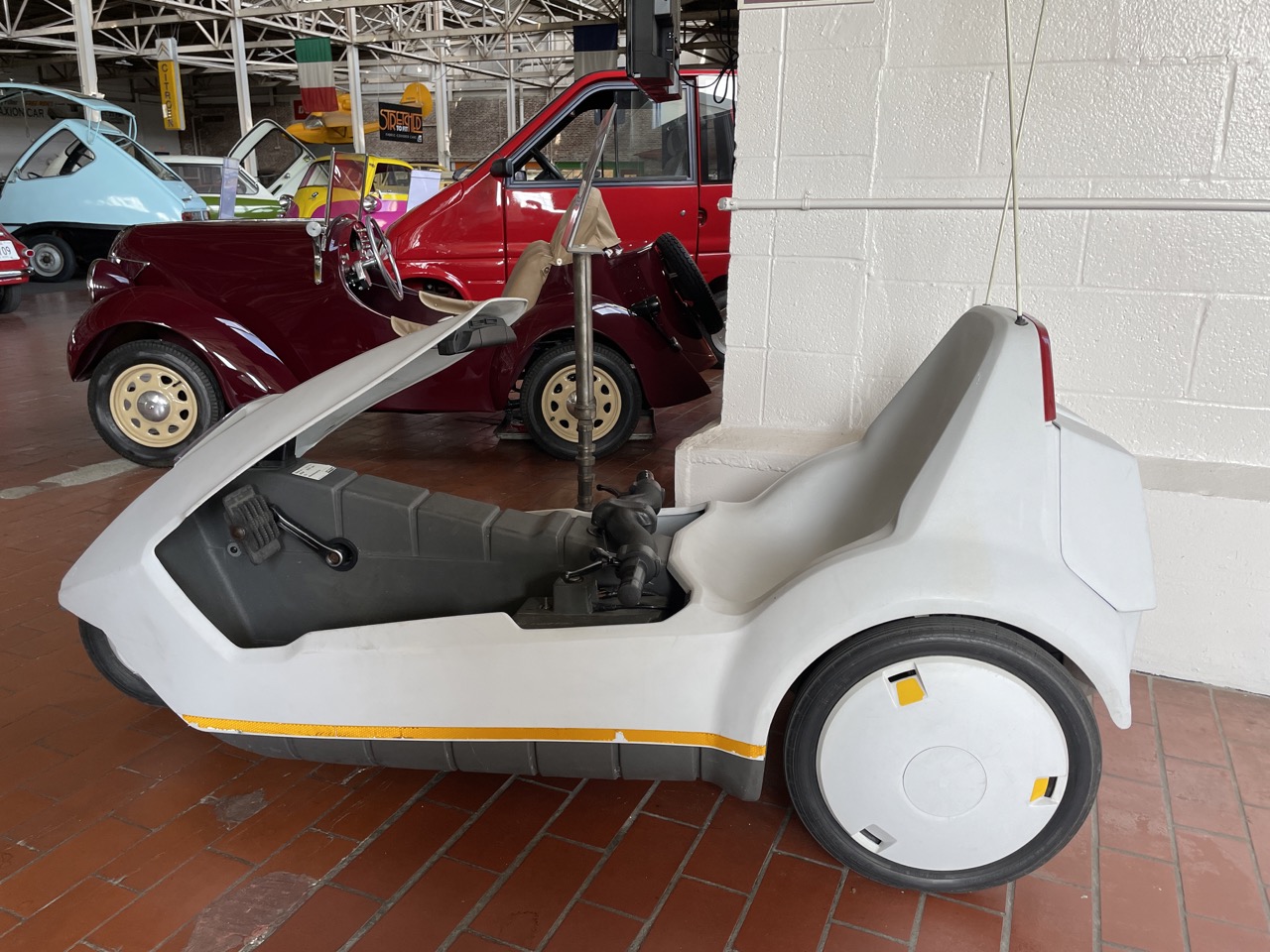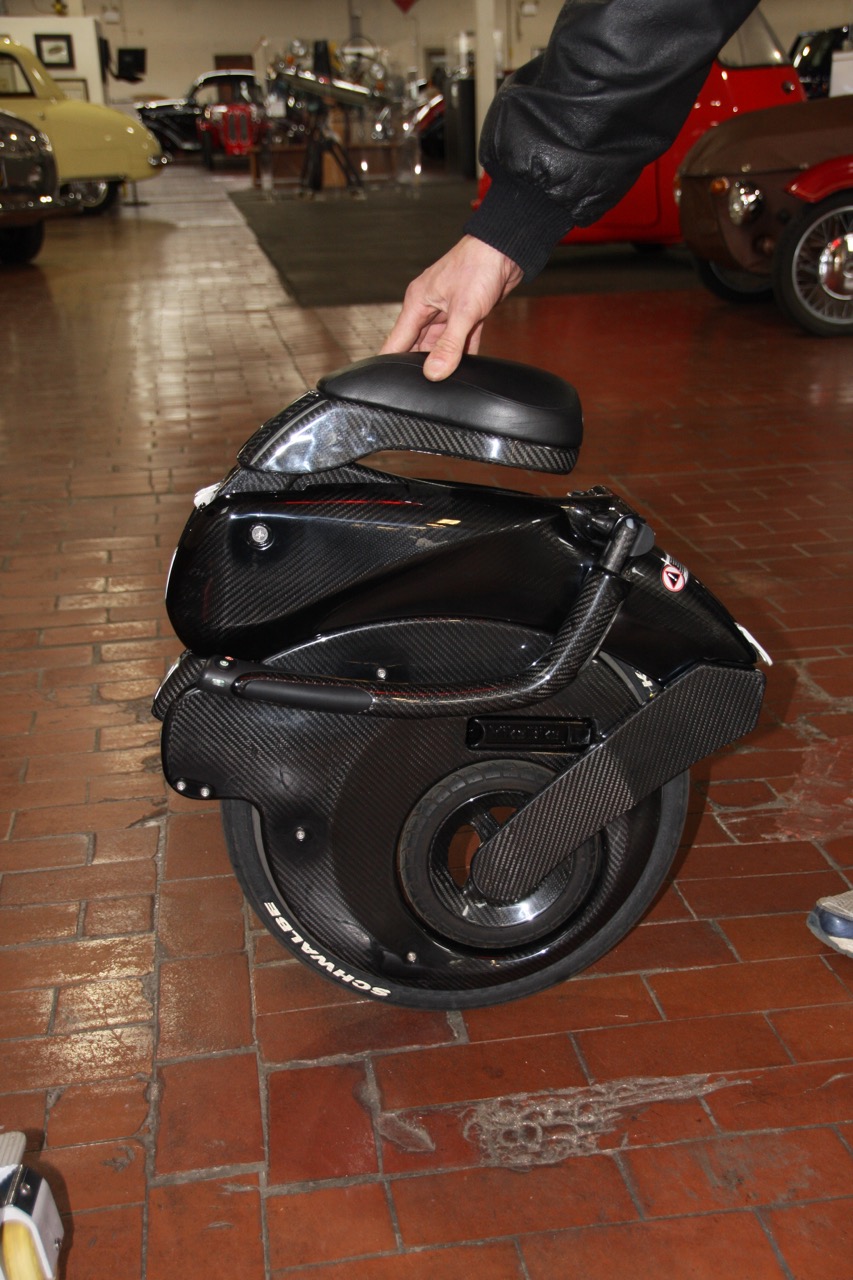The idea of adding an electric motor to a bicycle first appeared in a US patent in 1895 by Ogden Bolton Jr (Bolton? Oh, come on!) of Canton, Ohio, who was either forward-thinking or just a lazy peddler. The museum doesn’t have one of these Bolton hub motors (the company name was RIGHT THERE), so if any of you Autopians are into late 19th century safety bicycles and happen to run across one of these bad boys, let us know!
Hercules E1
We’ll skip ahead a few years to the earliest electric scooter in our collection, this 1974 Hercules E1. Hercules was founded in 1886 by Carl Marschütz as a bicycle manufacturer in Nuremberg, Germany. The first Hercules motorcycle debuted in 1904. Marschütz, being Jewish, fled to America during World War II, and by the end of the war 75% of Hercules’s factories had been destroyed. German automotive parts company ZF Sachs purchased the company in 1963.
In response to the 1973 oil crisis, Hercules developed this all-electric scooter, the E1. The 750 watt Bosch electric motor uses two 12 volt lead-acid car batteries. The E1 was primarily used for short trips in urban environments. Curiously, the pedals are in the WORST position to use it effectively, so I am guessing Hercules put them on there for the E1 to be counted as a moped.
Sinclair C5
Our next stop is 1985, when the infamous Sinclair C5 debuted. The Bishop just reimagined what this electric tricycle could have been, but Sir Clive’s idea would nonetheless be an important stepping stone in developing what we know today as last-mile commuters: lightweight, electric mobility options for urban professionals. Also, this British TV advert for the C5 is extremely 1980s:
[Editor’s Note: The nice Lane people let me drive this thing a few years back. It’s pretty amazing. Here, look:
— JT]
1998 Peugeot Scoot’elec
This 1998 Peugeot Scoot’elec is considered to be the first successful mass-market electric scooter. It was based on Peugeot’s entry-level gas scooter, the Zenith. Although the Scoot’elec’s 25-mile (40km) range wasn’t great, the performance and expected operating costs were. As fast as its conventionally-powered twin, estimated energy costs for an average year – 4000km of use – was expected to cost around 16 Euro, or $23. The Scoot’elec shared both body panels and suspension components with the Zenith, but differed greatly in the frame. The on-board charger, controller, and cord are stored beneath the seat, leaving only an irregularly-shaped cubby up front for storage. The electric model used a low-slung twin-cradle design, allowing the three heavy batteries to be placed below and behind the rider’s feet, keeping the center of gravity low. These three 6V Saft-brand monobloc NiCad batteries provided the Scoot’elec with both its power and also its Achilles heel. Requiring dealer-only service every 2000km, it was said that the cost of maintenance on the batteries could easily cost more than twice as much as the cost to charge it for a year. To operate it, one inserts and turns on the key, and then a 4 digit code is entered on the keypad. The bike is now ready for “Roll Handling” mode, limited to 4 mph (6 kmh); a press of the right thumb on the yellow button, and “Road” mode, or normal operation is enabled. Top speed in Road mode was legally limited to 28 mph (45 kmh), although it is well accepted that the Scoot’elec could do 34 mph (55 kmh), but not for long. An Eco mode was also available, by either choice or necessity. If one desired longer range but slower speed, a code could be entered into the keypad limiting speed to 19 mph (30 kmh); if one ignored the “charge now!” warning lights, Eco mode would automatically be engaged, whether you chose it or not. I think this thing is rather heavy, but I’ll bet that’s more 1990s componentry than anything else. Peugeot made the Scoot’elec until 2006.
2007 Vectrix VX-1
This 2007 Vectrix VX-1 is similar to the Scoot’elec in size, but was considered to be the performance option for electric scooters in the mid-2000s. The VX-1 is supposedly capable of a top speed of 60 mph, which is impressive for a scooter. If you keep your hand out of the throttle and ride it normally, it had a claimed range of 65 miles. Again, pretty good for the day.
2008 e-Solex
This e-Solex from 2008 is a modern, electric version of the iconic VéloSoleX 3800 moped that was designed by Pininfarina.
As a nod to its gas-powered predecessor (above), what looks like the distinctive front fuel tank is actually a lockable storage compartment, which also supports the front headlight. The e-Solex has a top speed of 20 mph (32 kph) in normal mode, with a range of 15 miles per charge, while the ECO mode uses less electricity, but is also less powerful. Top speed in ECO mode is 17 mph (22 kph), but range is 37 miles per charge.
2011 Peugeot AE21
Peugeot began manufacturing bicycles in 1882, eight years before their first internal combustion car was introduced. They are still a major manufacturer to this day, under the Cycles Peugeot name (they’re just not available for sale in the US). This 2011 AE21 Hybrid E-bike’s design integrates a lithium-ion battery into its aluminum frame. This allows space at the center of the bike for a laptop bag and a folding lock. It is propelled by a 250-watt electric motor located in the front wheel hub. The 36V battery stores 334 watt-hours of energy, for a range of up to 30 miles. A cool feature of the AE21 is that the battery can be recharged directly on the bike or removed for recharging at home or the office. It also features folding handlebars and pedals for easy storage.
2011 Mando Footloose
This 2012 hybrid-electric Mando Footloose, which sounds like some sort of Star Wars-themed dance you’d see on TikTok, is considered to be the world’s first chainless bicycle. Instead of a chain, mechanical energy from pedaling is converted to electrical energy via an alternator and is then fed directly to the battery. So, in this hybrid scenario, you are the engine generating electric power. The battery has an 18-mile range, which can be extended considerably by pedaling. It has a top speed of 15mph, and can also fold for easy storage and transportation.
2011 Yike Bike
And finally, this folding, fully electric, scaled-down penny farthing is a 2011 Yike Bike. It is definitely something that takes a bit of practice to ride. The throttle and brake controls are wrapped around your rear end, so you feel like you’re riding the Yike Bike backwards. I joke when I demonstrate this thing that the Yike Bike is aptly named, because that’s the sound you make when you first goose the throttle and it takes off.
The Yike Bike is very light, about 25 pounds when it’s all folded up. Its top speed is 15 mph, and the range is only about eight miles. All of that sounds fine and dandy, until you check their website, and find out this little bastard’s MSRP is $4,995!! What?! Thanks but no thanks, I’ll walk those eight miles, sans helmet, at roughly 5 mph, and save the cash. Sheesh!
I see a future for microcars designed to use electric bike parts.
We’re one massive energy/resource crisis away from the possibility of electric velomobiles or velomobile-shaped cars taking off as car replacements for some. You can ride enclosed, staying dry in the rain, and due to aerodynamic drag reduction, it doesn’t take much battery to go far. A well designed safety cell can provide some rudimentary collision protection, making it safer in a crash than most motorcycles.
My 16 lb 1.5 kWh battery pack gets me 150-200 miles of range at 30-35 mph with light to moderate pedaling, in a vehicle that weighs 91 lbs. It also does donuts on only 4 horsepower.
A single-seater commuter car without a bicycle drivetrain but built with a velomobile as a design inspiration could easily end up with more than 1 horsepower per pound of car, AWD via in-wheel ebike hub motors, operating it would be cheaper than taking the bus or light rail, and if mass produced, the raw materials cost to manufacture it could be comparable to a cheap moped or scooter. That, and I’m really fond of the idea of there being available an enclosed all-wheel-drive ultralight extremely inexpensive vehicle that accelerates from 0-120 mph in under 5 seconds. My prototype is a far cry from that, but I think I’ll eventually get there some day.
Somewhere on the internet there is probably video of me doing donuts in an intersection with the “Bike Life” crowd back in 2021, because when I did that, no less than 3 people had their phones out pointed at me while I was abusing a Schwalbe Marathon Plus Tour 26×1.5″ rear tire, but I’ve never been able to find it online. I don’t mess with social media, so that makes it all the more difficult.
I live in the hood and that thing attracts unwanted attention everywhere it goes. Especially from the police. Because of some legal technicalities, my vehicle isn’t illegal in my state and can pass as a “bicycle” and thus far it has never been confiscated, in the 20+ times it’s been pulled over.
I built my custom e-velo with traversing bad roads in mind. You can still have great aerodynamics even with increased ground clearance and extra suspension travel.
There was a prototype hub motor from AMZ Technologies used in a record-breaking acceleration attempt by the University of Zurich. It was an electric SAE car that did 0-60 mph in under 1.9 seconds. Each of the hubmotors weighed in at 7 lbs and could make 50 horsepower peak.
My custom built microcar/velomobile thing has a single Leafbike 1500W motor weighing in at 17 lbs, and the total vehicle weight is 91 lbs.
A completed microcar with no bicycle drivetrain, registerable as a motorcycle or autocycle, weighing in at around 150-200 lbs, with as much peak horsepower as lbs of weight, AWD, aerodynamics comparable to a commercial velomobile requiring only 5-6 horsepower to maintain 120 mph and 1 horsepower to maintain 60 mph, would be totally fucking insane. Hoonigans would shit a brick. And you’d be able to do 200 miles range speeding on the highway and otherwise operating it in a spirited manner with only a 5 kWh battery. LoneStar makes batteries with more than enough power density to pull it off, and a new 1 lb FOC ebike controller from PowerVelocity is about to hit the market that will provide the peak power needed to push these motors to their potential. Too bad those AMZ motors are not available off the shelf. There is nothing comparable. Using 3 cheap $300 Chinese Leafbike 1500W motors in their place and limiting each to 13 horsepower peak after adding hubsinks and ferrofluid, 0-60 mph in under 4 seconds is still doable for such a machine.
Think about this for a minute! There’s no reason fun EVs with long range need to be lardasses. None at all. In fact, the technology presents a unique opportunity to make vehicles much lighter than an equivalent ICE powered vehicle that could also readily out-perform it.
I’ve got two of their Electric Quads (one is for parts) and have seen one of their Electric Tricycles but haven’t yet managed to track down any surviving examples of their other vehicles.
https://live.staticflickr.com/65535/52360576879_792eeaeb17_b.jpg
https://live.staticflickr.com/65535/52360683105_14e4f023ea_b.jpg
https://live.staticflickr.com/65535/52360500773_46969da774_b.jpg
https://live.staticflickr.com/65535/52359711242_e4c486cd76_c.jpg
https://live.staticflickr.com/65535/52360973749_deb360c3e1_c.jpg
Is that a GM EV1 I see to the left of it in the first photo?
I like how they mentioned the contactor controller. In those days, a state-of-the art controller tended to use a silicon-controlled rectifier. Commercially available models from companies like General Electric and Cableform tended to be limited to 48V, with higher-performing models going up to 72V. They were thousands of dollars, in 1970s money, so the default solution was to use a series of contactors for speed control instead.
An EV conversion in those days with a contactor controller setup would use a series of switches underneath the accelerator pedal to swap different arrangements of contactors in the battery pack to vary the voltage directly applied to the motor, along with appropriately-sized resistors to keep in-rush currents reasonable. A 48V battery pack composed of eight 6V golf cart batteries could thus have 6V, 12V, 24V, and 48V selections, or four speeds. Couple that with a manual transmission, and you had a system that worked reasonably well.
That said, the most aerodynamic and long-legged conversions struggled to exceed 45 mph on 48V, and the amount of power lost as heat from contactor-controller setups was significant. The articles posted in the links from mdharrell mentioned 0.6 kWh/mile consumption for a VW Beetle! With a proper PWM controller, a VW Beetle is well capable of eeking out 0.2 kWh/mile or better efficiency.
With mass production of electronics, eventually the cost of real control systems came down in the 1980s, and did so with better and otherwise more expensive technology as well once MOSFETs became available. But if someone were to have mass produced an EV in the 1970s, SCR systems could have been made for cheap.
EVs of the 70s may have been slow by today’s standards, but impressive range figures were achieved. The CDA Towncar and McKee Sundancer were able to eek out more than 80 miles range in ideal conditions, and more than 50 miles range in real-world conditions, on golf cart batteries. They lacked significant aerodynamic streamlining.
If someone made a car as slippery as the 1935 Tatra T77A, that could have been turned into 100 miles range. There were also NiFe batteries from the early 20th century that had twice the specific capacity of lead acid and had been proven to work in real-world conditions(Jay Leno still has the functioning set, original, from his 100+ year old Baker Electric. Jut need to replace the potassium-hydroxide electrolyte on a regular basis to prevent corrosion), which could have then doubled that range. NiCd was another option, albeit a wreck might turn an area into a superfund site. I think a 100+ mph capable electric sedan with 0-60 mph acceleration of around 25 seconds, and 150+ miles range at the national 55 mph speed limit, was doable with 1970s crap-era tech, but I’m not sure anyone ever had such a vision, since such a prototype was never made. Other battery choices included Silver-Zinc, Sodium-Suphur, and Lithium-Nickel-Flouride, each with drawbacks that probably made them impractical for a production car back then, but nevertheless were demonstrated in various prototype vehicles getting 100+ miles range. It would have been interesting if someone tried to make such a vehicle for a production car.
Perhaps the closest we got was the 1967 AMC Amitron, which is said to have gotten a 150 mile range on a hybrid pack of lithium-nickel-flouride batteries, but that only seated 2 and topped out at 50 mph. There was also the 80 mile range 1966 Electrovair II that could reach 80 mph and fitted with a 115 horsepower AC drive, but the silver zinc batteries had a high materials cost.
The 1904 Baker Electric “Torpedo Kid” remained the fastest electric vehicle ever produced, for many decades, having topped out at over 100 mph. This is a testament to the impact of aerodymamics on performance(and also range), something that the auto industry routinely ignored then, and still doesn’t exploit to anything near its full potential today.
As far as one-person vehicles go, in the 2000s, Cedric Lynch put together a 60-mile range EV that used a single 12V battery. That was also doable in the 1970s. I like to think of what could have been if someone in the 1970s or 1980s made an electric microcar out of a Versatron Vector or a Cyclodyne human powered vehicle, reinforced to handle the extra weight and with wheels/tires appropriate for cruising at a minimum 55 mph top speed. I think we could have had 150+ mile range single-person EVs then as well, weighing in under 350 lbs.
And few people talk about just how fun these ebikes are to ride. In addition to using them for errands and short trips we often ride our 750W hub motor ebikes just for kicks. We’ve used them so much that the last time I went to the garage to check on Mrs. Shooting_Broke’s beloved S2000 (which I am sadly banned from driving) there were cobwebs in the wheel arches.
Also, that Yike Bike looks totally bananas and unsafe and I want to ride one.
https://www.thedrive.com/culture/we-found-motorolas-secret-chevy-corvette-ev-prototype-from-the-1990s
– The TWIKE , sort of a two person version of the Sinclair C5 but way more practical and with a bubble canopy. Invented in the mid-80s and went through a few iterations. These were actually made for a long time and there are rumors of a newer model. I got to ride/drive one in Seattle in the late 90s – while the tiller steering took getting used to, it was a lot of fun and very well made! Pedaling was surprisingly ergonomic, but was more of a range extender than a way of getting it going.
– ZAP Power Bikes, started making comically bad e-bike conversion kits in the 90s with lead acid batteries, before growing into other early electric vehicles. The brand Currie also made conversion kits, and theirs were better. Both these companies still exist in some form.
– Giant LaFree in late 90’s was one of the first “major bike brands” to sell an e-bike, and they even had a NiCad battery version (or maybe it was NiMh), not just lead acid. These bikes were very expensive at the time, but did have dedicated users.
Looks like the “new” versions of the Twike that are being hyped are just a pedal generator / exercise machine, with electric drivetrain.














